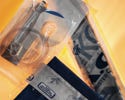The two-part standard harmonizes the requirements of ISO 11607:2000 and EN 868-1 into one global standard.
|
John Spitzley |
The International Organization for Standardization (ISO) has published a revised standard on the requirements for medical device packaging. ISO 11607, “Packaging for Terminally Sterilized Medical Devices,” is now two documents: Part 1, “Requirements for Materials, Sterile Barrier Systems and Packaging Systems” and Part 2, “Validation for Forming, Sealing, and Assembly Processes.”1
This two-part standard harmonizes the requirements of ISO 11607:2000 and EN 868-1 into one global standard, which should make it easier for medical device manufacturers to distribute their products internationally.2,3
History of ISO 11607 and EN 868-1
ANSI/AAMI/ISO 11607 addressed packaging for terminally sterilized medical devices; EN 868-1 covered packaging materials and systems for medical devices to be sterilized. Both documents were published in 1997 after a parallel development cycle that began in the early 1990s. When ISO TC 198, Working Group 7 (WG7), first gathered to begin work on a new ISO standard for medical device packaging, the intention was to meld the requirements of 868-1 into the ISO standard so that there would be one global document. For reasons too numerous and complex to discuss in this article, the working group decided to develop and publish ISO 11607 without total harmonization with EN 868-1.
|
Nick Fotis |
The European Committee for Standardization (CEN) Working Group TC 102 moved forward with its document, 868-1, along with its accompanying vertical standards. The understanding was that both documents would be harmonized at a later date, most likely when the ISO standard was due for its scheduled five-year review in 2002. Both standards were released and published in 1997. A guidance document, AAMI TIR No. 22, was also developed by the U.S. working group as a companion document to help users understand the requirements of the ISO standard.4
ISO 11607 was revised in 2000 to add notes that outline the requirements that would have to be met to be compliant with EN 868-1. By 2002, the changes needed to improve ISO 11607 were evident to the members of WG7. Even with the revisions made in 2000, ISO 11607 was not widely accepted or used in Europe. As a result, manufacturers outside Europe were often asked whether they complied with EN 868-1 even though they met the requirements of ISO 11607:2000. The structure of the ISO document—materials selection, forming, and sealing, followed by final (product) package—did not reflect the normal package development process. EN 868-1 was not without its own problems. It also did not read easily and did not effectively cover requirements for package design qualification, stability testing, or process validation.
As a result, WG7 voted on a new work item at a meeting in Kyoto, Japan, in May 2002. The new standard would harmonize the requirements of ISO 11607:2000 with those of EN 868-1. It would consist of two parts: Part 1, materials and package design, and Part 2, package assembly and validation requirements. The first draft of Part 1 was completed by Curt Larsen (DuPont), Jimmy van Veen (Johnson & Johnson/Cordis), and John Spitzley (then Medtronic, currently Spartan Design Group). The draft of Part 2 was written by Hal Miller (then Johnson & Johnson, currently PACE Solutions). During subsequent meetings in London, Frankfurt, and Sydney under the guidance of convener Mike Scholla of DuPont, the document went through several revisions and ballots.
The New and Improved ISO 11607
|
The new ISO 11607 improves the flow of package qualification and process validation during typical packaging development. |
One of the most critical issues in the development of the new standard was resolved in London when the international working group realized that terminology was one of the major deficiencies of the existing standard and the biggest roadblock to writing a new one. Terms such as primary package, secondary package, sterile package, barrier package, shipping package, and others were used indiscriminately in the standard and meant different things to different people. The group collectively decided to develop a set of four key definitions that would be used consistently throughout both parts of the standard. It was the breakthrough that served as the impetus for the development of the rest of the standard. These four definitions are as follows:
• Sterile barrier system (SBS): The minimum packaging that prevents ingress of microorganisms and allows aseptic presentation at the point of use.
• Preformed sterile barrier system: The sterile barrier system that is supplied partially assembled for filling and final closure or sealing, e.g., pouches, bags, and open reusable containers.
• Protective packaging: The packaging configuration designed to prevent damage to the sterile barrier system and its contents from the time of their assembly until the point of use.
• Packaging system: The combination of the sterile barrier system and protective packaging.
Other significant upgrades were made to the standard as well. The two-part document structure is also more indicative of real-life package development, i.e., materials selection, package design, and testing and process development and validation—in that order. Specific assignment of responsibilities for “shall” statements or requirements have been eliminated. The bottom line is that all requirements must be met, regardless of who fulfills them.
Two new annexes enhance the value of the document. Annex A provides an informative guidance and overview of medical device packaging. It is oriented to individuals who are new to medical device packaging and are unfamiliar with the discipline. Annex B consolidates all of the test methods that can be used to demonstrate compliance with ISO 11607-1 and 11607-2. The old standard had the test methods embedded in the body of the document, which sometimes made them difficult to locate. In addition, the test methods are categorized by applicability in the new version. Some of the categories listed are accelerated aging, integrity, performance testing, and seal strength.
Part 1. The key sections of Part 1, along with the annexes, are the Definitions list, General Requirements, Materials and Preformed Sterile Barrier Systems, Design and Development Requirements for Packaging Systems, and Information To Be Provided. The critical additions to the Definitions list are the four cited earlier. The General Requirements section discusses quality systems and sampling as well as test method and documentation requirements. The Materials section addresses general requirements (including physical and chemical properties, biological and toxicological attributes, cleanliness, compatibility with the manufacturing process, and other requirements), microbial barrier properties, sterilization compatibility, labeling system compatibility, and storage and transport requirements for sterile barrier system materials. The Design and Development section covers general requirements for packaging system design, the factors to be considered during the design process, package system performance testing, and stability testing for the sterile barrier system. Finally, there is a section that lists information to be provided with the sterile barrier and preformed sterile barrier system materials.
Part 2. Part 2 upgrades and expands on the requirements for medical device package process validation. This is a brand-new document that significantly improves the flow of the package qualification and process validation during a typical packaging development project. Based on work originally done by the Global Harmonization Task Force, Study Group 3, Miller modified the document such that it could be discussed in the international community.5 Before this document was published, EN standards did not require manufacturers to consider process validation and process control.
The prior EN 868 standards were focused mainly on package design and materials of construction. ISO 11607-2 brings process validation to the forefront. As the introduction states
One of the most critical characteristics of a sterile barrier system and packaging system for sterile medical devices is the assurance of sterility maintenance. The development and validation of packaging processes are crucial to ensure that sterile barrier system integrity is attained and will remain so until opened by the users of sterile medical devices.
It is important to note that the standard does not only apply to medical device manufacturers. It also is applicable to healthcare facilities, hospitals, and reprocessors: basically anywhere that medical devices are packaged and sterilized. Equally important, the processes used to produce preformed sterile barrier systems must be validated. In other words, companies that manufacture chevron-style pouches, for example, must validate their processes.
Upon beginning to review the new Part 2, readers will find that they are familiar with many of the sections. In fact, the Definitions section is almost a duplicate of that found in Part 1. The meat of Part 2 begins in section 4.0 with a section titled General Requirements. Section 4.3 covers Test Methods. One of the key requirements of the standard is that all test methods must be validated. This is often mistakenly understood to mean that it is sufficient to use a standard test method that has gone through some sort of round-robin testing and has been accepted by a standards-setting body. However, this is not the case. The requirement is for the specific lab that performs the testing to validate the test method in its lab with its people on its instrumentation. A good approach to documenting this validation is to rerun the studies that first provided the round-robin justification to ensure that the new results are in alignment with the prior data. Scholla is spearheading a movement within the international community to adopt the approach that, within five years, all test methods referenced in the back of the document will have reliability and reproducibility data to substantiate them. There is an annex that lists many suitable test methods.
Section 5, Validation of Packaging Processes, covers general requirements for validation, but also standardizes terminology across the industry by stating that validation should include installation qualification (IQ), operational qualification (OQ), and performance qualification (PQ)—and that they must be done in that order. Validation may rely on data from previous IQ and OQ qualifications, but a rationale is required whenever similar preformed sterile barrier systems and sterile barrier system manufacturing processes are used. Worst-case configurations must be justified and documented.
A list of considerations is provided for the IQ. Critical process parameters must be defined, controlled, and monitored. During the OQ, process parameters must be challenged to ensure they will produce systems that meet all defined requirements. This would normally include both upper and lower parameter limits. Considerations are provided in the document for forming and assembly, sealing, and other closure systems.
For the PQ, it is noted that actual or simulated product may be used. The standard also notes that the OQ process parameters must be confirmed and that product and package requirements must be verified. By putting in place process control measures and proving process capability, process repeatability, and reproducibility, the PQ can be completed. The document also has requirements for package system assembly, use of reusable sterile barrier systems, and sterile fluid path packaging.
Conclusion
The two-part ISO 11607 standard harmonizes the requirements of ISO 11607:2000 and EN 868-1 into one global standard. The recently published standard should make it easier for manufacturers to meet the packaging requirements for terminally sterilized medical devices.
It is important to note that AAMI is revising and reissuing Technical Information Report number 22. This document is intended to provide guidance for applying ISO 11607 under the FDA regulatory framework. Currently the document is in the revision stage, but plans are for the report to adopt a cookbook-style layout that uses a chronological approach to packaging development. The TIR will have no new requirements, but rather it will serve as a guide to applying ISO 11607 Parts 1 and 2. The TIR committee is being cochaired by Jan Gates of Guidant and Ram K. Singhal of the Flexible Packaging Association.
John Spitzley is principal of Spartan Design Group (Hudson, WI). He can be reached at [email protected]. Nick Fotis is director of packaging for Cardinal Health (McGaw Park, IL). He can be reached at [email protected].
References
1. ISO 11607, “Packaging for Terminally Sterilized Medical Devices, Parts 1 and 2” (Geneva: International Organization for Standardization, 2006).
2. ISO 11607:2000, “Packaging for Terminally Sterilized Medical Devices” (Geneva: International Organization for Standardization, 2000).
3. EN 868-1, “Packaging Materials and Systems for Medical Devices Which Are To Be Sterilized, General Requirements and Test Methods” (Brussels: European Committee for Standardization, 1999).
4. AAMI TIR No. 22, “Guidance for AAMI/ANSI/ISO 11607-1997, ‘Packaging for Terminally Sterilized Medical Devices'” (Arlington, VA: Association for the Advancement of Medical Instrumentation, 1997).
5. GHTF Study Group 3 Guidance Document [online]; available from Internet: www.ghtf.org/sg3/sg3.htm.
Copyright ©2006 Medical Device & Diagnostic Industry
About the Author(s)
You May Also Like





